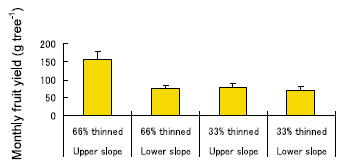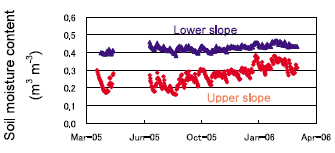The effectiveness of the medicinal plant noni as a cash crop in agroforestry
Description
Agroforestry systems are anticipated to contribute to sustainable forest management and the improvement of local economies. We have focused on agroforestry systems as a technology for forest rehabilitation from degraded secondary forests and derelict plantations of fast-growing tree species in Sabah, Malaysia. Our previous findings suggested that Acacia mangium is usable as a nurse tree to provide suitable conditions (e.g., the correct amount of shade) for seedling establishment of indigenous tree species such as dipterocarps. Choice of suitable cash crops which can be cultivated under Acacia mangium trees is essential to permit forest rehabilitation to be integrated with the cultivation of cash crops.
Demand for medicinal and herbal products has recently increased worldwide due to health fads. Noni (Morinda citrifolia, Rubiaceae) is one of the most popular medicinal plants. It has been used for treatment of various ailments such as hypertension, diabetes, and poor digestion. We monitored the growth performance and fruit yield of noni to examine its potential as an agroforestry cash crop under Acacia mangium trees.
A field census was conducted at an agroforestry experimental plot (1.6 ha) in an 18-year-old (as of 2006) Acacia mangium plantation at the Kolapis-A Research Station, Lungmanis Forest Reserve, Sabah. The plot slopes from east to west. It consists of subplots with different thinning treatments (unthinned, 33% thinned, and 66% thinned). In 2003, noni seedlings were planted in each subplot together with seedlings of indigenous species including dipterocarps, fast-growing species, and cash crops such as fruit trees. Ripe noni fruit were harvested and weighed every month. Soil moisture content was measured using an ADR sensor (Delta-T Devices, Ltd.). Water permeability was measured using falling head permeability tests (DIK-4012, Daiki Rika Kogyo Co., Ltd.).
Noni fruit were harvestable from 1 year after planting. The highest fruit yield was found on the upper slope with 66% thinning (Fig. 1). Soil moisture content was constantly higher on the lower slope than on the upper slope all year round (Fig. 2). Higher water permeability was detected on the upper slope than on the lower slope (1.6 × 10-2 to 2.7 × 10-3 cm s-1 on the upper slope versus 2.0 × 10-3 to 2.6 × 10-5 cm s-1 on the lower slope). These results suggest that high light conditions and good drainage are preferable to obtain high fruit yields of noni under Acacia mangium plantations. Thus, noni has potential as a useful cash crop under Acacia mangium plantations, provided light conditions and soil drainage are managed.
Figure, table
-
Fig. 1. Comparison of monthly fruit yield of noni between upper and lower slope at different thinning rates (from August 2005 to January 2006). -
Fig. 2. Variation in soil moisture content at 10 cm soil depth.
- Affiliation
-
Japan International Research Center for Agricultural Sciences Forestry Division
- Classification
-
Technical A
- Term of research
-
FY2006(FY2006~2011)
- Responsible researcher
-
MIYAMOTO Kazuki ( Forestry Division )
YAMADA Tsuyoshi ( Forestry Division )
OTA Takayuki ( Forestry and Forest Products Research Institute )
KAMO Koichi ( Forestry and Forest Products Research Institute )
LAPONGAN Jaffirin ( Forest Research Centre, Sabah )
- ほか
- Publication, etc.
-
Miyamoto,K., Yamada,T., Ota,T., Kamo,K., Nakamura,S. and Lapongan,J. (2006): Growth performance, photosynthesis traits and fruit yield of Mengkudu (Morinda citrifolia) under an Acacia mangium stand. Abstract of International Agroforestry Conference (IAC) 2006, 26.
- Japanese PDF
-
2006_seikajouhou_A4_ja_Part19.pdf608.22 KB


